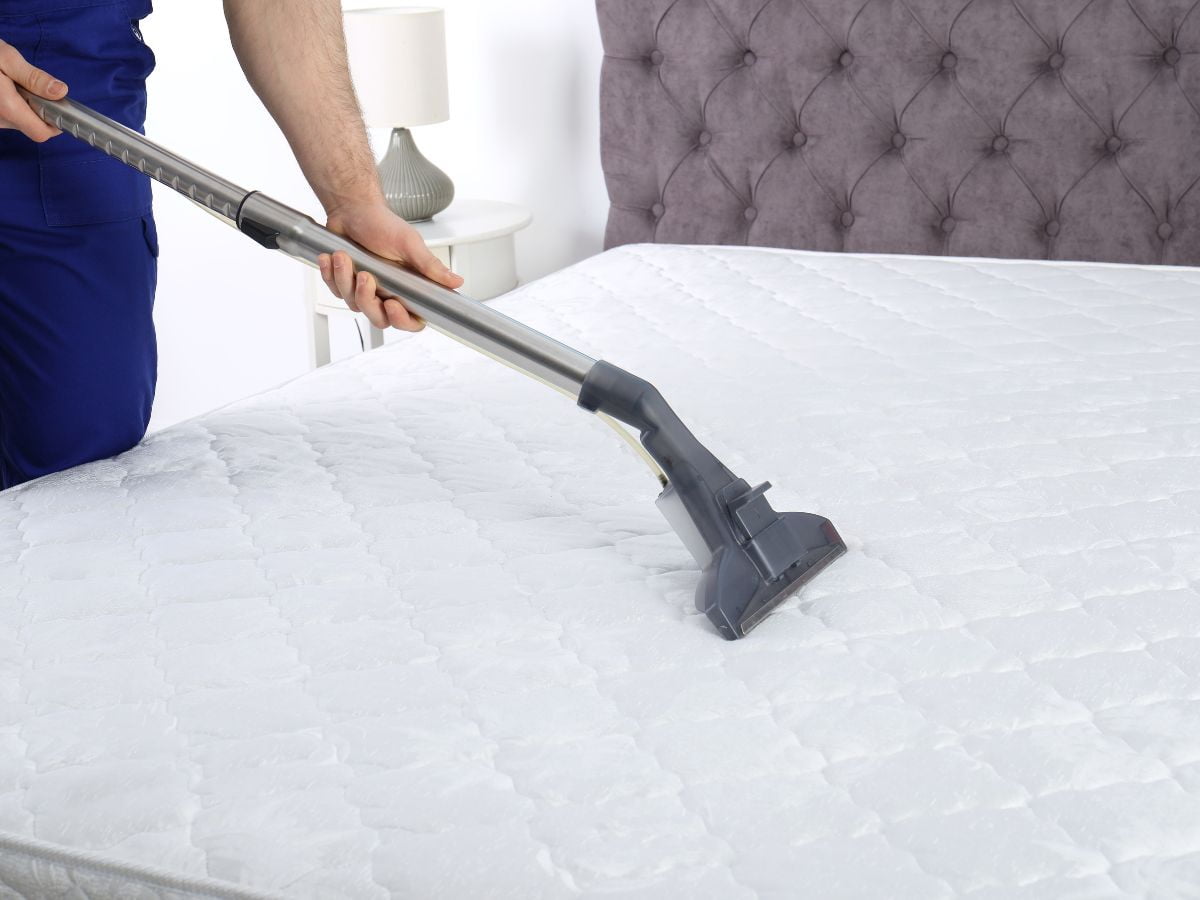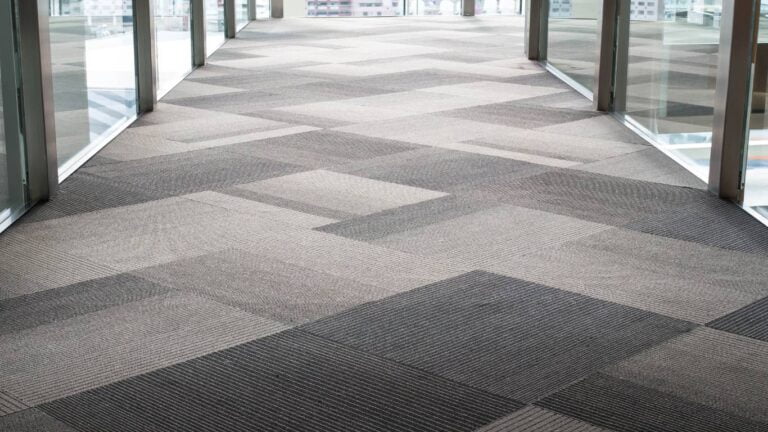DIY mattress cleaning is your ticket to a fresh, hygienic sleep sanctuary without having to seek out a professional service. Embarking on this journey to cleanse and deodorise your mattress not only contributes to a more pleasant sleep experience but also extends the life of your mattress. This guide offers a comprehensive walkthrough of the cleaning process, from assessing the type of mattress you own to the specifics of spot cleaning, deodorising, and deep cleaning techniques. Whether you’re dealing with an unexpected spill or committing to regular maintenance, we’ll provide practical tips and natural solutions to tackle stains, odours, and allergens. By following these steps, you can ensure that your mattress remains a clean and inviting place of rest, safeguarding both your comfort and health.
Preparing for Mattress Cleaning
Assessing Your Mattress Type and Material
Before you start cleaning your mattress, it’s important to know what type and material you’re dealing with. Different materials might need special cleaning methods and solutions to avoid damage. For example, memory foam and latex mattresses are particularly sensitive to moisture and chemicals, so you’ll want to clean these carefully.
Gathering Cleaning Supplies
To clean your mattress effectively, you’ll need the right tools and cleaning agents. You’ll need a vacuum with an upholstery attachment to get rid of dust and debris. You’ll also need cold water, gentle laundry detergent, dish soap, or an enzyme cleaner for those pesky stains.
If you’re looking for a more eco-friendly option, you can use natural cleaning solutions like a mix of vinegar and water or baking soda. For tougher stains, a concoction of baking soda, dish soap, and hydrogen peroxide can do the trick when applied with a spray bottle. Make sure you’ve got clean rags or towels on hand for blotting and rubbing stains.
Timing: When to Clean Your Mattress
Keeping your mattress clean is key for a hygienic sleeping environment and should be done about every six months. But if you spill something, it’s best to tackle it right away to stop the stain from setting in. If you’re using a waterproof mattress protector, you might not need to clean your mattress as often.
Protecting the Cleaning Area
Before you dive into the cleaning process, make sure your cleaning area is well-protected. Strip all bedding and covers from the mattress. Cleaning in a well-ventilated space is a good idea to help the mattress dry and to keep moisture from getting trapped.
If you can, let your mattress bask in sunlight and fresh air by opening a window or taking it outside, which can also help kill bacteria and mould. After cleaning, think about getting a mattress protector, pad, or encasement to guard your mattress against future dirt, spills, and allergens. Washing your sheets regularly and not eating or drinking in bed will also help keep your mattress clean.
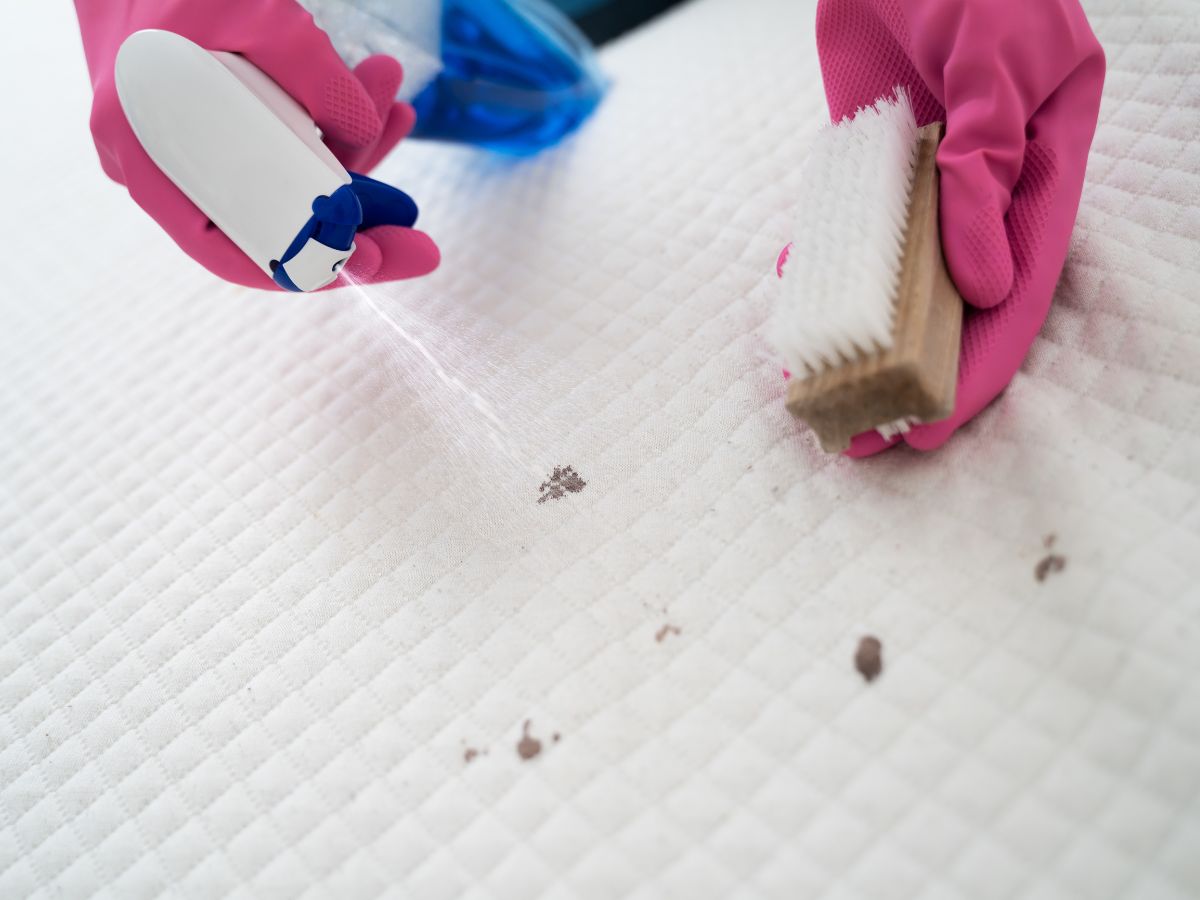
Spot Cleaning Stains
Identifying Common Types of Stains
Understanding the specific types of stains on your mattress can inform the best approach to remove them. Sweat, blood, and urine are common culprits that not only mark the appearance of your mattress but can also foster bacterial growth and odours.
DIY Stain Removal Solutions
A variety of household items can be effective in addressing mattress stains. A concoction of equal parts liquid dish soap, hydrogen peroxide, and water can be particularly effective against sweat-induced discoloration.
For deodorising and disinfecting, a solution of equal parts water and white vinegar can be beneficial. However, it’s prudent to consult the manufacturer’s cleaning recommendations, as some mattress materials may require specific care.
Gentle Blotting vs. Scrubbing
Immediate action is crucial when dealing with spills. Absorb as much liquid as possible by pressing down with a clean cloth or paper towels. Afterward, a soft brush or cloth can be used to lightly scrub the affected area in a single direction, avoiding vigorous scrubbing that could worsen the stain.
Addressing Persistent Stains
For stains that resist initial treatment, reapplication of the cleaning solution followed by additional blotting and gentle scrubbing may be necessary. Allowing the solution to sit for a few minutes can enhance its stain-lifting power.
In cases where stains persist, professional cleaning services may be required, particularly for set-in or particularly stubborn marks. Regular maintenance, including vacuuming with a HEPA filter vacuum and periodic deep cleaning, can prevent stains from becoming permanent. You can view our mattress cleaning services here.
Deodorising Your Mattress
To maintain a fresh and hygienic sleeping environment, it’s beneficial to deodorise your mattress semi-annually, or more frequently if you have allergies.
Using Baking Soda
An effective method for neutralising acidic odours involves a light dusting of baking soda over your bare mattress. Allow the baking soda to sit for several hours before vacuuming it off with a handheld vacuum cleaner equipped with an upholstery attachment. This not only refreshes your mattress but also helps to absorb moisture and body oils.
Natural Deodorisers and Their Benefits
Enhance the deodorising effect by adding a few drops of essential oils such as lavender or chamomile to the baking soda for a calming fragrance. Alternatively, a combination of cornstarch and baking soda can be used for a more potent effect against body oils and odours, with the cornstarch aiding in moisture absorption.
Tips for a Fresh Smelling Mattress
For more challenging stains, a solution of equal parts distilled white vinegar and water can be lightly sprayed over the mattress, taking care not to drench it. Allow it to air dry completely. For spot cleaning, a paste made from gentle laundry detergent and baking soda can be applied directly to stains. Regular vacuuming with an upholstery brush attachment can also help remove dust, dirt, and pet dander.
Ventilation and Air Flow
Promoting good ventilation by stripping the bed and allowing air to circulate can help prevent moisture accumulation. Use a fan to enhance airflow and expose your mattress to sunlight to naturally freshen it and assist in lightening stains.
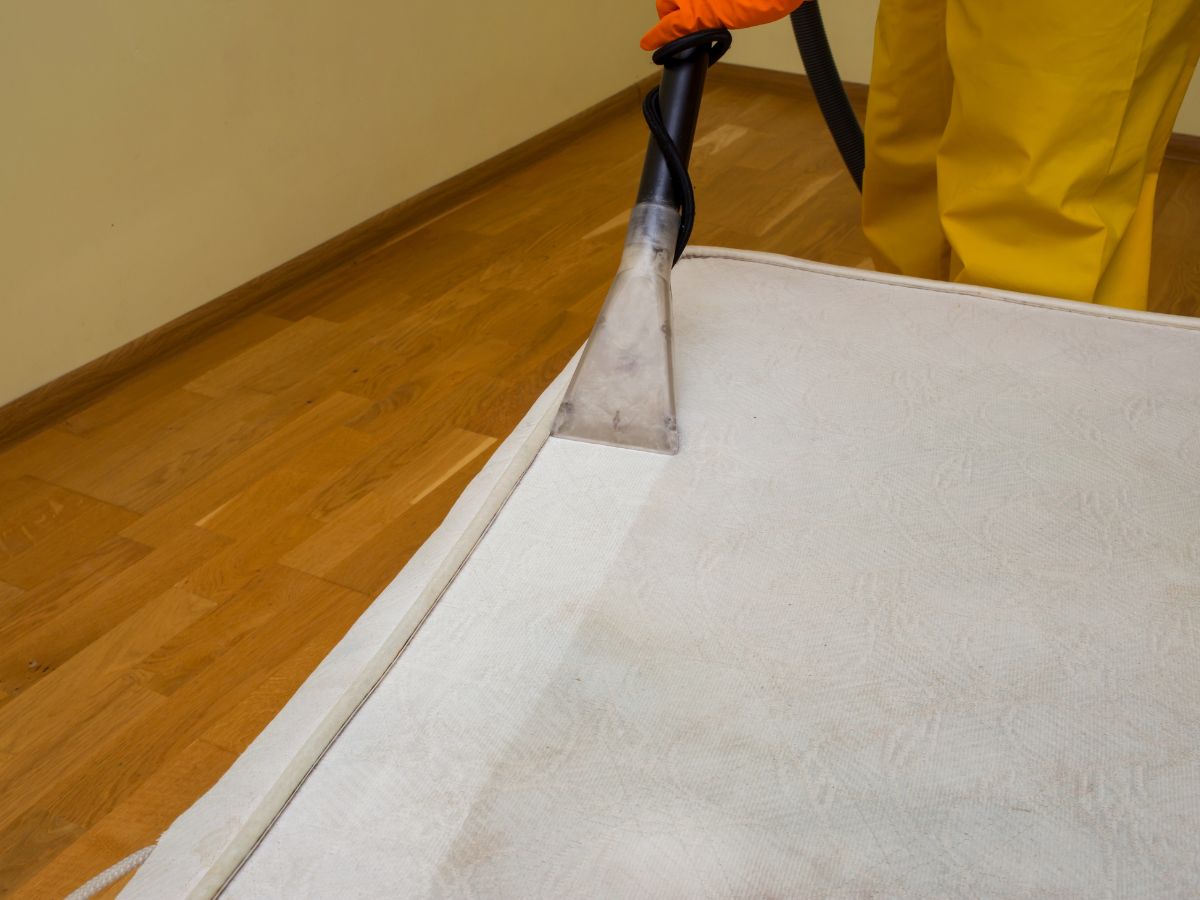
Deep Cleaning Your Mattress
Steam Cleaning Techniques
Steam cleaning is a thorough method to refresh your mattress, capable of eliminating bacteria, dust mites, and even stubborn stains. You’ll need a steam cleaner, which could be handheld, canister, or upright. The steam should reach temperatures between 100 to 121 degrees to be effective.
You’ll want to plan this activity carefully. Pick a day when you won’t need the bed for several hours, ideally starting in the morning to give it plenty of time to dry. Good ventilation is key to prevent the growth of mould and mildew, which can happen if the mattress stays damp.
Before you start, strip all bedding and vacuum the mattress. Pre-treat any stains with a suitable laundry stain remover. Once you’re ready, steam the mattress, making sure you don’t soak it, and allow at least three hours for it to dry completely.
Keep in mind, steam cleaning isn’t suitable for memory foam or latex mattresses because of the potential damage from heat and moisture. If you have pets or small children, or if you’re caring for someone bedridden, you might need to steam clean more often. On the other hand, if the mattress isn’t used much, cleaning it once a season should be enough.
Dry Suds Method for Delicate Fabrics
For mattresses with delicate fabrics, such as those labelled with Code “S”, a dry suds method is better. This technique uses dry cleaning solvents or dry foam cleaners, which can dissolve oily residues without the risks that come with water-based cleaning methods, like bleeding or shrinkage. When you apply a dry foam cleaner, it’s often towelled onto areas with heavy soiling to lift oils and dirt.
After application, speed up the drying process with increased air movement and ventilation. It’s important to use solvents safely, ensuring good ventilation, avoiding smoking, and wearing appropriate respirators as needed.
Vacuuming Best Practices
Regular vacuuming is a key part of mattress maintenance, helping to remove dust mites, bacteria, and other allergens. Use the upholstery attachment or a bristled attachment to effectively dislodge and remove debris from the mattress fibres. Focus on the top, sides, and any seams or folds where allergens are likely to accumulate.
If you have allergies, asthma, or pets, you might want to vacuum your mattress more often. It’s also wise to rotate or flip your mattress periodically to prevent uneven wear.
Handling Memory Foam Mattresses
Memory foam mattresses need special care due to their sensitive material. For regular cleaning, use a vacuum with a soft brush attachment to gently remove dust and allergens.
If stains occur, go for a mild detergent mixed with water, apply it sparingly, and gently dab the area. Make sure the mattress is completely dry before you put the linens back on. To keep your memory foam mattress in top shape, use a waterproof protector to guard against spills and stains, and keep a moderate humidity level in the bedroom to prevent mould and mildew.
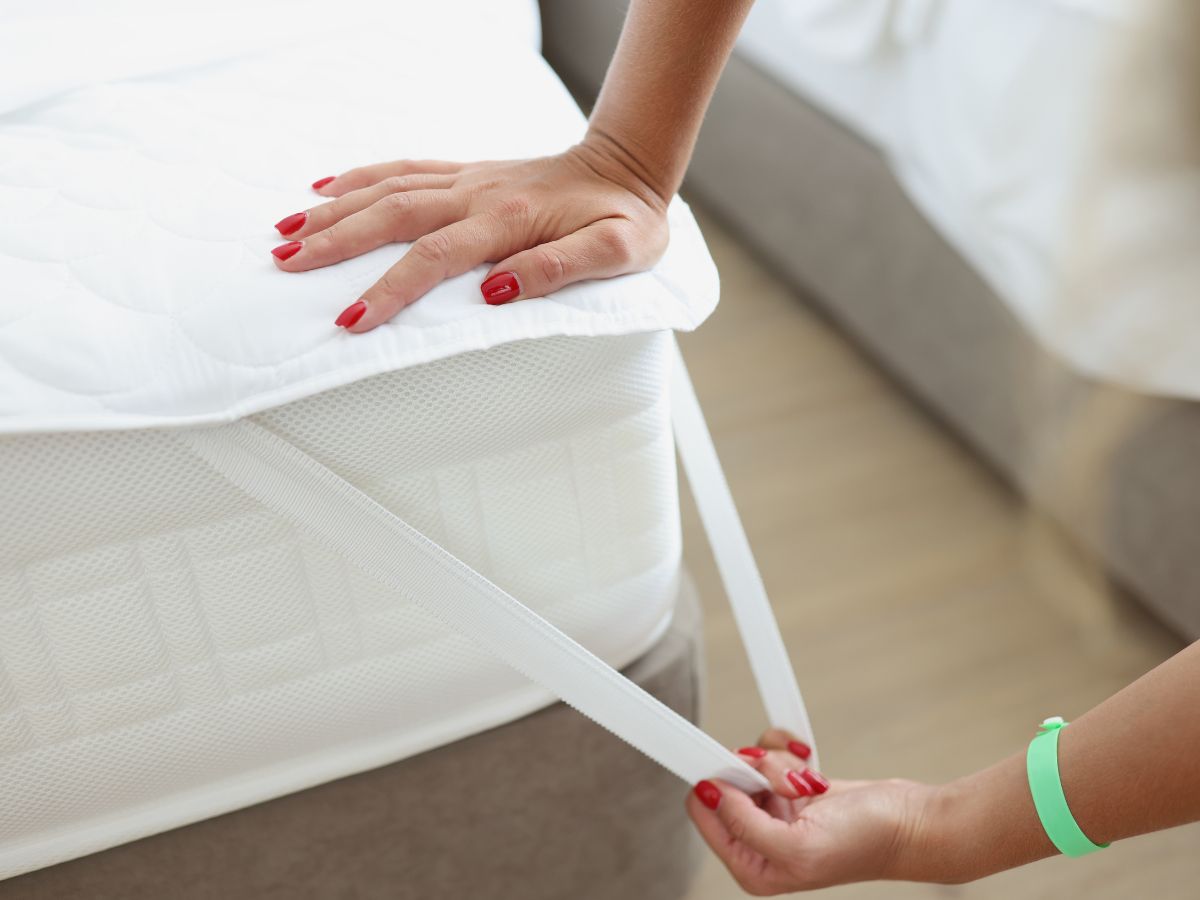
Maintaining Mattress Cleanliness
Protective Covers and Their Use
Employing protective covers is a proactive measure to maintain mattress hygiene. These barriers are instrumental in shielding your mattress from contaminants and can reduce the frequency of in-depth cleanings.
Ensuring your mattress rests on a proper foundation is also critical to maintain its integrity and your comfort. Adhere to the manufacturer’s recommendations for the appropriate base to maintain the warranty.
When to Consider Professional Cleaning
Despite diligent maintenance and the use of protective covers, there may be instances when professional intervention is warranted. Persistent discomfort or sleep disturbances could indicate the need for a more comprehensive cleaning or even mattress replacement.
In some cases, a mattress topper can provide temporary comfort and extend the lifespan of your mattress. However, if discomfort persists, seeking professional advice and services may be necessary.
If you are interested in professional mattress cleaning, you can request a quote here.
Rest Easy with a Clean Mattress
Your journey to a fresh, allergy-friendly sleep zone doesn’t have to be complicated or expensive. By following these simple DIY cleaning tips, you’re not only preserving the quality and longevity of your mattress but also ensuring a healthier sleeping environment.
Regular maintenance using natural ingredients can be both effective and gentle on your mattress, saving you from frequent professional cleanings. Remember, the key to a pristine mattress lies in addressing spills immediately, maintaining a consistent cleaning routine, and using protective coverings to their full advantage.
Keep your sleeping sanctuary in top condition and enjoy the peace of mind that comes with knowing you’re resting easy on a clean, cared-for mattress. Sweet dreams!

